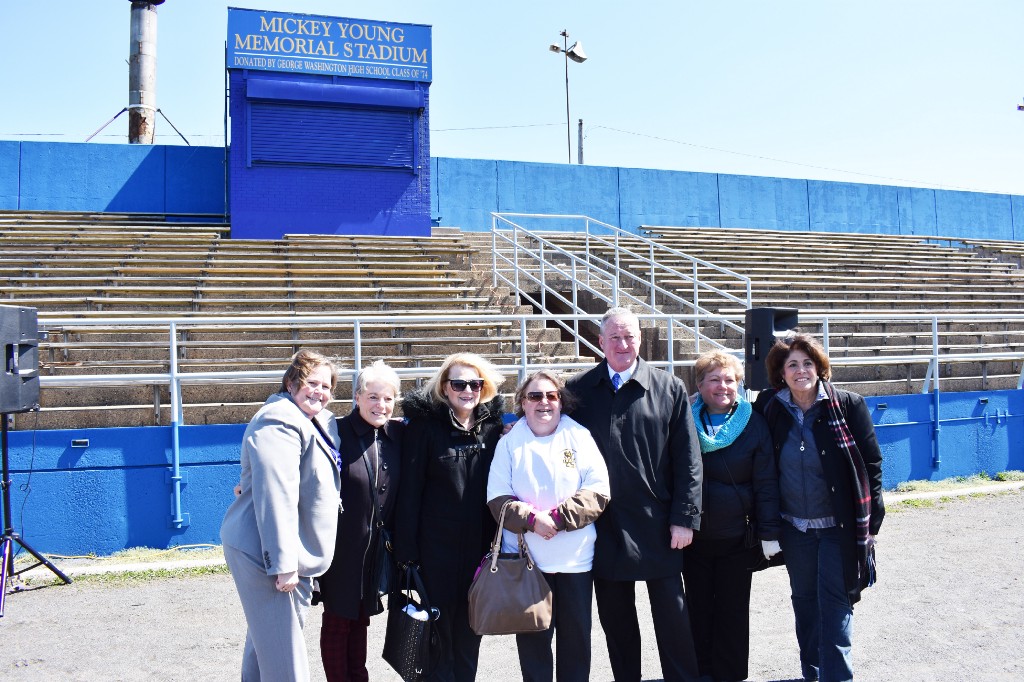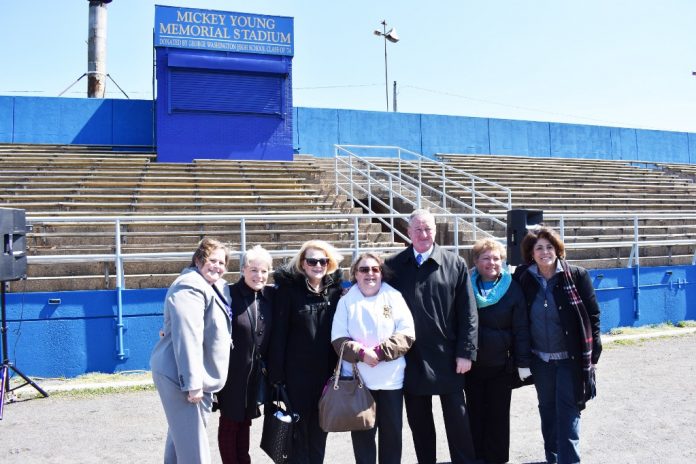George Washington High School has decided its goals as a community school, and aims to “change the landscape of high school education.”

It took 20 apprentices and 1,440 hours of work, but the football stadium outside George Washington High School looks brand new.
“Before, the paint was chipping and it just looked like it hadn’t been taken care of in a while,” said Principal Susan Thompson, standing on the field now lined by two bleachers painted bright blue to match the school’s color.
The stadium was unveiled April 20 to coincide with the Day of Action 2018 held by the International Union of Painters and Allied Trades. Over the course of a month, apprentices from the Finishing Trades Institute worked with students to paint the stadium. The school’s graphic design class also designed logos and other patterns they will stencil onto the bleachers.
“The icing on the cake here is the opportunity our students had to gain work exposure to a viable, family-sustaining career path,” Mayor Jim Kenney said at the stadium on Friday.
Giving students hands-on experience is a priority for the school. Since becoming a community school at the start of the school year, students, teachers and surrounding community members participated in surveys, focus groups and interviews on what community-boosting efforts they would like to see the school focus on. The school has decided on three primary priorities.
Employment Supports
The community school’s goal is to give students more preparation for a successful post-high school life, whether they go to the workforce or college. It also wants to provide surrounding community members with opportunity and job training. This includes opportunities like letting students design and paint the bleachers, or sending freshmen to the Bustleton Library where they can help customers with computer issues.
“Job training for adults came up at the top,” said Caitlyn Boyle, community school coordinator. She said it was in the top two priorities for adults for nearly every stakeholder surveyed. Some 8.5 percent of residents 16 years or older are unemployed. Meanwhile, 58 percent of students wanted college information, while 57 percent wanted help finding jobs.
Starting in May, the school will partner with JEVS Human Services to host a series of workshops that focus on resume writing, interview skills, online job search and more skills for adults. On June 14, a small job fair will be hosted at the school.
For students, the school has partnered with a local nonprofit Blush and Blazers, which assists women with achieving their career goals, according to its Twitter. There will be a job fair for places like Burger King, Wendy’s and Sesame Place.
The school also secured 20 spots (with the possibility for more) with the Philadelphia Youth Network’s WorkReady program, which will provide part-time work at rec centers over the summer.
These are just a fraction of the opportunities students and adults will have. Starting next year, students will be able to participate in nine workshops that prepare them with interview skills, managing workplace stress and more.
“The more we expose the students to different opportunities, the better educated they are,” Thompson said. “We’re modifying the curriculum to increase relevance to all different career paths and trajectories.”
Social and Cultural Opportunities
“In the focus groups, kids said they feel like they didn’t have anything to do,” Boyle said, “and if they had positive things to do, they would do them.”
The school is putting out a call for art: students and community members will be able to submit a 12×12 picture that will be displayed along the school’s outer walls. The theme is representing the artists’ “journey.” When putting them all together, the wall is supposed to resemble a patchwork quilt.
The school will receive about $1,200 from a Wells Fargo grant to the Mayor’s Office of Education, which will be dedicated toward community events. One idea is purchasing a projector to play movies outside during the summer. Boyle said another idea is to partner with Eat Right Now and the Common Market to launch a new farmer’s market that will feature food and local vendors selling their crafts. The community could see these events come to fruition as early as this summer.
“We’re not stopping,” Thompson said. “There’s too much to do.”
Support for Immigrants
Nearly half of the people who live within 1,000 feet of the school (49 percent) were born outside of the United States. More than three-quarters of the student population are economically disadvantaged (77 percent), and 18.2 percent are English language learners.
The school offers two adult English as a Second Language classes taught at the school, and is trying to add a third due to high demand. A few teachers are trying to become certified to teach ESL classes as well. As the programs continue to expand, the school hopes to add classes to help achieve citizenship.
“People want to come, want to work, want to help their kids at school, and they know the first thing they need to do is learn English,” Boyle said.
The school has also already practiced the Speak program, which matches immigrant girls with experts in the field they want to work in.
For secondary focuses, the school will tackle Support for Youth Learning and Development, Support for Substance Abuse and Healthy Food Access.
“In a year from now, I envision all of the things that are just coming together now will be a well-oiled machine,” Boyle said. “Kids will know about it, parents will know about it, the community will know about it.”
Goals are ambitious, but Thompson is confident in her staff, and more importantly, her students.
“We will churn out students who are lined up for apprenticeships or already in college with college credits,” Thompson said. “We’re changing the landscape of education. We’re changing what education looks like at a comprehensive high school.” ••





